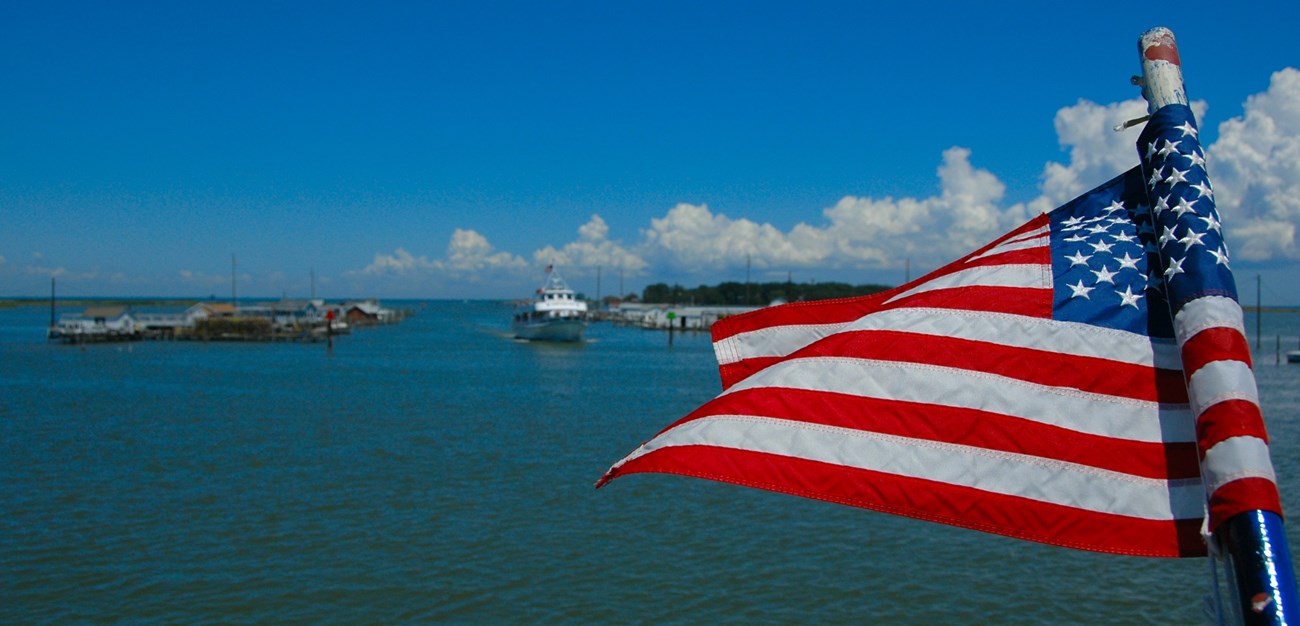Victories Turn Tide of War
A series of rare victories provided a turning point for the nation. On September 11, 1814, the American victory in the Battle of Lake Champlain stopped the British invasion from the north.
The successful American defense in the Battle for Baltimore, September 12–15, 1814, proved to be another defining moment for the United States, and the victory influenced the peace negotiations then underway.
The outcome of the war helped fuel a nascent sense of nationalism in many Americans. They began to think about what it meant to be American. Instead of identifying themselves as Marylanders, Virginians, or citizens of other states where they lived, people began to think of themselves first as Americans. Foreign nations also began to look at the young republic with new respect after the United States survived a conflict with the world's most powerful navy.
Before the War of 1812, the United States’ flag was primarily a utilitarian marker, serving to identify ships and military forts. At the end of the War of 1812, both the flag and the "Star-Spangled Banner" song became iconic national symbols in the United States and the rest of the world.
The Treaty of Ghent that officially ended the war called for a return to the status quo, so neither side won territory. But most Americans believed that the United States had won the War of 1812. A “selective memory” glossed over the defeats and close calls. Americans generally felt pride and high morale as the nation entered an “Era of Good Feelings.”
The flag and anthem that endure from the War of 1812 continue to ask each generation of Americans: “O’ say does that Star-Spangled Banner yet wave/ O’er the land of the free and the home of the brave?” The lines of the lyric challenge Americans to define freedom, bravery, and patriotism for themselves and to ensure that the nation lives up to the claim of “the land of the free and the home of the brave.”
Civic Pride
In the Chesapeake region, cities embraced their role in the War of 1812 and quickly erected memorials and monuments.
On the two-year anniversary of the Battle for Baltimore, the city council passed a resolution calling for a day to commemorate the battle. This became known as Defenders Day, and from 1907 to 1996 September 12 was an official Maryland state holiday. For the centennial of the War of 1812, Baltimore hosted a week-long celebration. As part of the centennial the frigate Constellation was restored to its 1814 appearance for display in the Baltimore harbor.
Although not the original vessel that protected fortifications at Craney Island in the War of 1812, a second Constellation had an illustrious history for nearly a century and is now on permanent exhibit in Baltimore.
The War of 1812 is still part of the culture of many Chesapeake Bay communities:
-
Baltimore’s city seal and flag depict Battle Monument, the first monument constructed in the United States to commemorate the War of 1812.
-
Defenders Day, though no longer an official holiday, is still marked with commemorations and reenactments.
-
Baltimore’s famous privateer ship the Chasseur, known as the “Pride of Baltimore,” was memorialized with the near replica Pride of Baltimore. Today, Pride of Baltimore II is Maryland’s modern-day ambassador on the seas, and the crew offers tours and educational programs.
-
St. Michaels, Maryland, calls itself as “The Town That Fooled the British.” According to legend, during the war, St. Michaels turned off all its lights and put lanterns in trees outside of town. When the British fired their cannons, they overshot the town.
-
Brookeville, Maryland, still touts that it was “United States Capital for a Day” while the British occupied Washington August 24, 1814.
-
Taylor’s Island and Madison, Maryland, are proud of the local Battle of the Ice Mound, during which militiamen took prisoner the crew of a British ship that had become iced in near the mouth of the Choptank River.
-
Petersburg, Virginia, calls itself the “Cockade City” for the leather cockade hats worn by the Petersburg Volunteers (the local militia) during the war.
Monuments and memorials to the War of 1812 dot the Chesapeake region, particularly in the Baltimore area. In Maryland, the Maryland Historical Trust maintains an inventory with information about the locations of War of 1812 markers.

